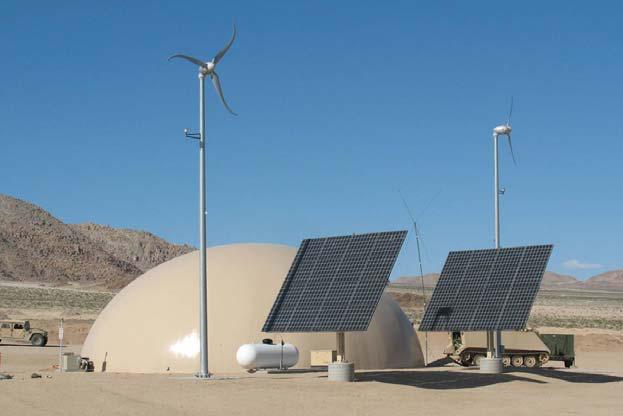Tessa Knight, a cadet of the US military academy is on a Portland-bound United Airlines flight after completing her final semester of her second year. Fatigued and weary, Knight says, “I feel miserable. I have just given a very tough physics exam on renewable energy and haven’t slept the entire night. I’m looking forward to going back home and catching up on my sleep.”
For over a year, the military academy has been rolling out a set of new courses focusing on energy and use of renewable fuels. Deeply concerned about the future outlook of oil prices, the military is preparing itself for alternative fuels. Educating the cadets is an effort in that direction.
The immediate outlook for oil prices is unclear. Weak demand amid strong supply is expected to keep prices low in the medium term. Demand from faster-growing non-OECD countries is forecast to outpace demand in OECD countries. In addition, an increase in domestic production of oil in the United States is likely to reduce its dependence on international crude oil. However, nearly all forecasters agree on one thing: The long-term outlook is for sharply high prices.
This is disturbing news for the US military. The Department of Defense is the single largest user of oil in the world, consuming 355,000 barrels of oil each day and approximately 120 million gallons of oil in a year. For every 25 cents increase in a gallon of oil, the US military fuel bill increases by $1 billion. As the defense budget tightens, the DoD has been preparing to insulate itself from market volatility and global price hikes – and one option the department has proposed is using biofuels rather than fossil fuels. However, there is an elephant in the room. The National Defense Authorization Act, the central piece of legislation outlining the defense budget, restrains the flexibility of the defense department from the production and purchase of any alternative fuels that cost more than traditional petroleum based fuels. Targeted at the DoD’s biofuels program, this prohibition has ignited a debate on how the military plans to reduce its dependence on foreign oil.
DoD’s largest opportunity for renewable fuel use is in its tactical systems and weapon platforms qualifying for 90% of its petroleum fuel demand. Conforming to existing fuel specifications and performance requirements is however a pre-requisite for renewable fuels used in the system. Renewable fuels must qualify and weapon platforms must certify before being used in tactical systems to ensure the fuel does not compromise mission performance or safety.

There is however a fair chance that renewable fuels will face military doctrinal challenges. To simplify fuel logistics, the DoD currently uses a single battlefield fuel (JP-8), while the proposed renewable fuels require separate supply chains or are incompatible with existing infrastructure.
DoD has been exploring the use of renewable fuels in tactical applications through the Services’ comprehensive test and evaluation programs. The services’ technical communities are testing and qualifying drop-in renewable fuels. Certification roadmaps are being developed with plans to procure substantial volumes of renewables over time. So far, it has been determined that renewable fuel blends that meet military diesel and jet fuel specifications will not require separate infrastructure or pose maintenance risk to existing assets.
The DoD faces two crucial challenges. The first is securing adequate supplies. To be able to procure a sufficient supply of drop-in renewable fuel, particularly jet fuel to meet the demand of DoD looks difficult. With the given goals and projected supply, DoD would have to aim for more than 40% of the renewable and cellulosic diesel and jet markets in 2020. The current goals far exceed even the high-end projected domestic supply.
The second challenge is cost. Drop-in renewable fuels are expected to cost more than their petroleum counterparts. In 2015, the estimated price premium will be between $1.43 and $5.24 per gallon. Mid range estimates suggest that DoD’s drop-in renewable fuel use would represent an additional annual fuel cost of $865 million by 2015 and $2.2 billion by 2020. This would beat least 10-15% higher than the cost of conventional petroleum fuels.

Creating a new commodity class for renewable fuels is a possible way to gain greater leadership support and visibility, but an opposing view suggests that the associated redundant infrastructure costs and user acceptance impediments outweigh the benefits.
In the short term, bio-fuels are expected to cost much more but there is a strong likelihood that as the largest consumer of energy, the defense department will be able to drive down costs through its investments. Department of Energy predicts that the cost of biofuels could be as low as $2.32 a gallon by 2017.
Air Force Lt. General Norman Seipargued spoke against the proposed restriction in an op-ed article published by TK publication earlier this week. “What if Congress would have passed a similar legislation prohibiting the military from developing GPS until satellites cost lesser than charts and maps or banned the use of jet fuel until it was cheaper than a gallon of regular?’ Supporting the sentiment, a DoD report states that ‘the payoff to DOD from reduced fuel demand in terms of mission effectiveness and human lives is probably greater than for any other energy user in the world.’

The Office of Naval Research, in the meanwhile, remains committed to the development of alternative energy sources and is moving forward with a new research effort, “The Energy Systems Technology and Evaluation Program.” The evaluation program is bringing together key players during a five-year period to conduct real-world tests on advancing energy technologies at the Navy and Marine corps installations.
Chief of Naval Research Rear Admiral Matthew Klunder made the case for the program in a recent report: “The life blood of innovation is in new ideas and you don’t get new ideas without collaboration across industry, academia and DOD. The partnerships at work under this new program and the alternative energy technologies we are exploring are vital to our energy independence and to the training and education of our sailor and marine energy work force.”
In addition to evaluating and testing alternative energy technologies, the ESTEP program looks to give Department of Navy, personnel training and education opportunities to become part of the future energy workforce.
Partnerships with the energy industry include a new energy curriculum at the Naval Postgraduate School, as well as courses for veterans and wounded warriors at San Diego State University. These programs focus on innovative commercial energy technologies obtained from open-market sources, including small businesses. They also study business side of energy technologies by analyzing the costs, savings and return on investment of different efforts.

“ESTEP is a great opportunity to put alternative energy programs on Navy and Marine Corps bases and really understand how it’s going to work in the field. We’re taking this new energy frontier into a realistic working environment” , an ONR program officer Sharon Beermann-Curtin told Publication TK recently.
There is little doubt about the benefits of embracing alternative fuels for the military. The debate is about the logistical and realistic framework within which this can be made a possibility. An increase in DoD renewable fuel use would contribute to US national security interests, achieve service energy security goals and offer military utility. However, it is also obvious that the projected supply of drop-in renewable fuels will not be sufficient to meet anticipated DoD demands for renewable jet fuel products. The budgetary implications will also need to be taken into account, as price premiums for drop-in renewable fuels may be considerable.
